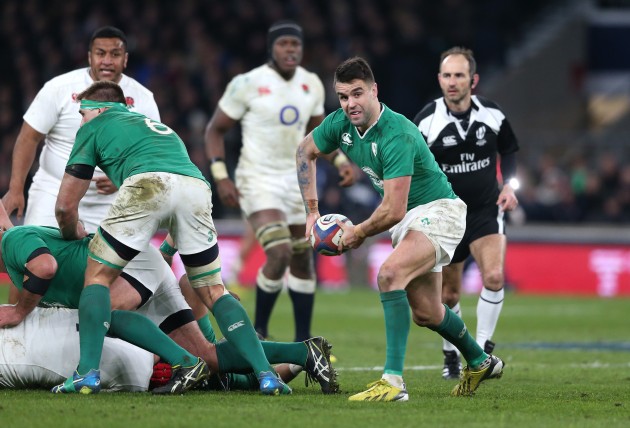An 11-point loss, but there were causes for optimism at Twickenham for an injury-depleted Ireland side, with Italy and Scotland up next, they could finish with a flouris
By Whiff of Cordite
England ultimately overpowered Ireland to win by more than a score but the outlook for Ireland was weirdly positive. A measure of how far they’ve sunk in the last twelve months perhaps, or a realistic assessment given the high number of debutants and off-the charts injury problems? Here are our views on a day of mixed emotions.
It was about as good as losing by 11 points to England got
The French defeat felt somewhat empty, because it was obvious Ireland had lost to a malfunctioning and patently unfit side, but there was plenty of encouragement to take from this game; so much so that the overall sense was one of pride in the team in their courageous defence and refusal to buckle when England threatened to run away with it.

Handful: Ireland didn’t have anyone who could stop a rampaging Billy Vunipola on Saturday
We don’t have a player in the Billy Vunipola mould, few teams do, and he was more or less unplayable on the day. Yet, apart from Big Billy, there was little to choose between the sides.
Fundamental concerns
For all the misplaced handwringing about Ireland’s style of play and lack of offloads, the biggest problem has in fact been a decline in the basics which proved the building blocks of their success in the last two years. The much-fabled hyper-efficient rucking went down the toilette against France, while Ireland’s ability to reclaim high kicks has disappeared, and they haven’t aerially dominated any team in this campaign.

Set-piece concerns: The lineout, once a strength, has been misfiring in this Six Nations
The would-be catchers have knocked on a huge amount of contestables. The other weak suit this year has been the lineout, and Ireland have too often failed to secure their ball from precious lineouts in the opposition 22. It’s an expensive habit. Ireland’s defence also looks oddly passive, constantly on the back foot once the ball is thrown wide. They repeatedly gave up easy metres here.
Ver Kidz to the Fore
Much of the encouragement comes from the performances of the three debutants, in particular the explosive impact of Connacht second-row Ultan Dillane. You wait and you wait for a tackle-breaking ball-carrying strongman in the second row and then two come along in the space of a couple of years.

Off to a flier: Josh Van der Flier impressed on his debut at Twickenham
Josh Van der Flier’s one-two-one link-up with him to almost secure a try hinted that he may yet be the – Irish Rugby Commentariat Moment coming up – Genuine Openside™ that we’ve been looking for since… ever. Stuart McCloskey mixed things up a bit, and earned some critique from Joe Schmidt, but he showed some of his barnstorming capabilities in the wide channels, and is worth another go in the remaining matches.
Too much rugby?
Ireland don’t play any rugby; so goes the popular thinking in pubs and opinion pieces, but if anything they were guilty of playing too much rugby here, especially in their own half. However, early in the second half they did show an ability to make metres by going wide. Johhny Sexton showed that class is permanent by producing a vintage display – as well as nailing his kicks superbly – and pulled the strings expertly.

In the clear: Johnny Sexton put in a vintage performance against England making several line-breaks
Conor Murray had another fine match and is Ireland’s top – okay, only – try scorer of the tournament. We can only hope that the decision to keep the pill and try to find space will reap greater rewards against Scotland and Italy, who are defensively less efficient than England.
Form worries
Rob Kearney was a little improved but has been way off his best for some time. Andrew Trimble had an alarmingly poor game, dropping balls and missing tackles. He is starting to look slow for a test wing.

All wrapped up: Rob Kearney hasn’t exerted the influence he can have for a while
And while Cian Healy is only returning from injury, his lack of any sort of form and dire scrummaging performances have been the story of his season. Does it do him any good to be rushed back into this sort of arena. History has shown us that test rugby is no place to try and play into form. Alternatives may well be worth a look.
For the latest Rugby World magazine subscription offers, click here.






